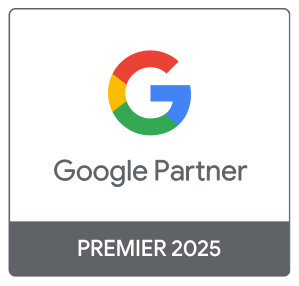To understand the importance of flat-fee PPC management, we first need to understand how Google Ads and Pay-Per-Click (PPC) marketing work.
PPC marketing is exactly what it sounds like; you only pay when someone clicks on your digital ad. Google uses several different factors to determine the price you pay for a click. Google determines the cost per click (CPC) of a company’s PPC ad campaign through an auction-based system that considers the ad’s maximum bid, Quality Score, and Ad Rank. The ad with the highest Ad Rank is displayed first, followed by the ad with the second-highest Ad Rank, and so on. The CPC for each ad is then determined by dividing the Ad Rank of the ad below it by the Quality Score of the ad.
If your ad gets clicked, you will only pay the amount of the next highest bid plus one cent.
For instance, if you’re willing to pay $7 for a click and the next highest bidder is only willing to pay $5 for a click, you will only pay $5.01 if your ad is clicked.
Budget
The budget is determined by the company running the ads (client and agency together). You can choose any budget you would like to run with, and most agencies will take that budget and break it out amongst the days of the month.
For example, let’s say you decide that your budget is $1200/month. Divide that amongst 30.4 (average number of days per month) days of the month and you get a budget of $40/day. If the cost per click on your campaign is $5, you should get 8 clicks through to your website per day.
Why do we break this out per day?
Very simply, we do this to make sure that your media spend can stretch the entire month, so that you don’t end up spending your entire budget within the first few days of a campaign.
How is the CPC Determined?
CPC or Cost Per Click is built on an auction-type model. Say you’re willing to pay $5 per click, but your competition comes back and says they’re willing to pay $5.50 per click.
You decide what you’re willing to pay the max and from there, your campaign is created. If the two companies have the same quality score, then the ranking of the companies in the ad section is based on what they’re willing to spend per click.
What is Quality Score?
Quality Score is the score associated with the ads to ensure that Google shows the best ads based on the search inquiry made. The way Google determines this is based on a couple of key factors:
- Click Through Rate (CTR): The CTR tells you how many people who’ve seen your ad end up clicking on it. This metric can help you gauge how enticing your ad is and how closely it matches your keywords and other targeting settings. Note that a good CTR is relative to what you’re advertising and on which networks.
- Bounce Rate: The bounce rate is the percentage of single-page visits. The bounce rate is the percentage of visits in which a person leaves your website after visiting the landing page without browsing any further.
- Navigation: Once the user lands on the landing page, where do they journey to on the site? Which pages do they visit and in what order?
The better the quality score, the less you need to spend on your ads to ensure you rank higher on Google. If your budget is $5 and your quality score is a 7, then your final number is 35.
If your competitors’ budget is $5.50, but their quality score is a 4, then the final number is 22. Meaning you can rank higher on Google Ads while spending less money than your competitors strictly by having better Ad Content and a stronger website.
Flat-Fee PPC vs. Percentage of Media Spend: Which is Better?

Because working with a company that takes a flat-fee means that the company is working for you to increase the quality score of the ads and to drop how much you actually need to spend on Google to obtain the best results.
If you work with an agency that takes a percentage of the media spend, they are incentivized by your spending as much as possible on Google ads, and therefore do not have a vested interest in increasing your quality score. They want you to spend as much as possible.
Your agency should be working for you, not against you.
With flat-fee PPC, you know exactly how much money is being spent on Google Ads, and more importantly what your local exposure is.
What is Local Exposure?
The local exposure is the percentage that the ads show up in relation to how much they could have shown up based on the budget and the current targeting parameters. One of the ways to increase local exposure is by increasing the budget.
Another strategy is to decrease the target area. This will also cause the local exposure to increase (because you will have fewer potential searches). This can be a very successful strategy by taking a look at which areas are driving the majority of your leads, saving money on low-performing geographical areas.
Why is this Important?
It allows you to analyze your current cost per lead and decide whether or not to increase what you spend on Google to expand your market share. If you have an occupancy problem, this is the easiest way to combat it. Be in front of people when they’re actively looking for you.
And the fact that your agency isn’t taking a cut gives you the peace of mind that the recommendation is made with your community’s best interest in mind. If you have questions about your marketing, contact our experts at CITIZEN.





